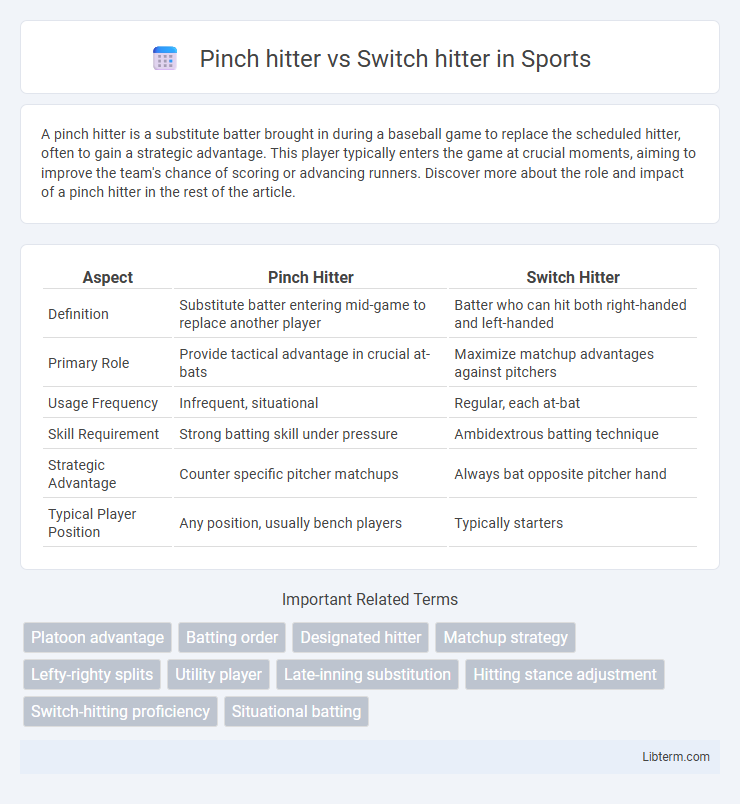A pinch hitter is a substitute batter brought in during a baseball game to replace the scheduled hitter, often to gain a strategic advantage. This player typically enters the game at crucial moments, aiming to improve the team's chance of scoring or advancing runners. Discover more about the role and impact of a pinch hitter in the rest of the article.
Table of Comparison
| Aspect | Pinch Hitter | Switch Hitter |
|---|---|---|
| Definition | Substitute batter entering mid-game to replace another player | Batter who can hit both right-handed and left-handed |
| Primary Role | Provide tactical advantage in crucial at-bats | Maximize matchup advantages against pitchers |
| Usage Frequency | Infrequent, situational | Regular, each at-bat |
| Skill Requirement | Strong batting skill under pressure | Ambidextrous batting technique |
| Strategic Advantage | Counter specific pitcher matchups | Always bat opposite pitcher hand |
| Typical Player Position | Any position, usually bench players | Typically starters |
Introduction to Pinch Hitters and Switch Hitters
A pinch hitter is a substitute batter called upon to bat in place of another player, often in crucial game situations to maximize offensive potential. A switch hitter is a batter capable of hitting effectively from both the left and right sides of the plate, providing a strategic advantage against pitchers of varying handedness. Understanding the roles of pinch hitters and switch hitters is essential for grasping advanced baseball strategies and lineup optimization.
Definition of a Pinch Hitter
A pinch hitter is a substitute batter in baseball who replaces another player during a crucial at-bat, often in late innings to improve offensive chances. Unlike a switch hitter, who can bat proficiently from both left and right sides of the plate, a pinch hitter is typically chosen for their specific hitting skill or matchup advantage against the pitcher. Managers use pinch hitters strategically to exploit pitcher weaknesses and increase the likelihood of scoring runs.
Definition of a Switch Hitter
A switch hitter is a baseball player capable of batting both right-handed and left-handed, allowing strategic advantages against pitchers of either hand. Unlike a pinch hitter, who substitutes for another batter in specific situations, the switch hitter maintains continuous versatility in the batting order. This skill enhances lineup flexibility and matchup potential, making switch hitters valuable assets in professional baseball.
Key Differences: Pinch Hitter vs Switch Hitter
A pinch hitter is a substitute batter who replaces another player during a game, typically brought in to gain a strategic advantage in a specific at-bat, whereas a switch hitter is a player skilled at batting both right-handed and left-handed to exploit pitcher matchups. The key difference lies in their roles; pinch hitters are situational substitutes, while switch hitters have the versatility to bat from either side of the plate regularly. Pinch hitters often enter mid-game to improve offensive chances, whereas switch hitters maintain constant adaptability throughout the season.
Strategic Uses of Pinch Hitters
Pinch hitters serve a crucial strategic role in baseball by replacing a weaker batter with a stronger hitter in high-leverage situations, such as late innings when a key run is needed. Managers often deploy pinch hitters to exploit favorable matchups against opposing pitchers, maximizing offensive potential without committing to a permanent lineup change. Their impact is most significant during critical moments, as successful pinch hitting can shift game momentum and directly influence scoring opportunities.
Advantages of Having a Switch Hitter
Switch hitters possess the unique advantage of batting from both sides of the plate, allowing them to exploit pitcher matchups and minimize platoon disadvantages. Their ability to adapt to left-handed or right-handed pitchers increases offensive versatility, leading to higher batting averages and on-base percentages. Teams benefit strategically by maintaining offensive pressure throughout the game while mitigating pitcher dominance based on handedness.
Famous Pinch Hitters in Baseball History
Famous pinch hitters in baseball history include legends like Lenny Harris, who holds the Major League Baseball record with 212 career pinch hits, and Manny Mota, renowned for his clutch hitting off the bench with 150 pinch hits. These players specialized in coming off the bench to deliver critical hits, often changing the course of a game with limited at-bats. Pinch hitters differ from switch hitters, who bat both right- and left-handed to gain strategic advantage during regular play rather than specialized situational appearances.
Legendary Switch Hitters and Their Impact
Legendary switch hitters like Mickey Mantle and Chipper Jones revolutionized baseball by mastering batting from both sides of the plate, increasing their strategic value in games. Their ability to adapt to pitchers' handedness not only boosted offensive production but also influenced team lineup decisions and gameplay tactics. The impact of these switch hitters remains significant, illustrating the skill and versatility required to excel in Major League Baseball.
Situational Considerations: When to Use Each
Pinch hitters are strategically used in high-pressure moments to replace a weaker batter, maximizing the chance of key hits during critical innings, especially against tough pitchers or late-game scenarios. Switch hitters provide lineup flexibility, adeptly adjusting batting stance to exploit pitcher matchups, making them valuable throughout the game to maintain competitive advantage against both left- and right-handed pitching. Managers weigh factors like game context, pitcher-batter matchups, and player fatigue to decide between deploying a pinch hitter or relying on a switch hitter's versatility.
Conclusion: Pinch Hitter or Switch Hitter – Who Gives the Edge?
Pinch hitters provide a strategic advantage by specializing in clutch situations, offering tailored hitting against specific pitchers to maximize run-scoring potential. Switch hitters increase lineup flexibility and maintain offensive consistency by batting from both sides, neutralizing pitcher matchups. The edge depends on team strategy: pinch hitters excel in situational leverage, while switch hitters deliver sustained adaptability throughout the game.
Pinch hitter Infographic

 libterm.com
libterm.com